AHS205 Report: Policy and Challenges in Australian Aged Care
VerifiedAdded on 2022/09/23
|10
|2123
|25
Report
AI Summary
This report provides a comprehensive analysis of the aged care sector in Australia, focusing on the influence of public policies, key stakeholders, and the challenges faced by the industry. It begins by identifying the Western Australian HACC Program as a relevant policy and outlining the stakeholders involved, including government departments, healthcare organizations, and unions. The report then delves into the challenges within the aged care sector, such as the need for skilled staff, the impact of technological advancements, and the increasing demands of an aging population. Furthermore, the report examines the impact of the aged care sector on social determinants like health and income inequality. It concludes by emphasizing the importance of government interventions, staff development, and stakeholder collaboration to improve aged care facilities and ensure the sector's sustainability as a vital pillar of the Australian economy.
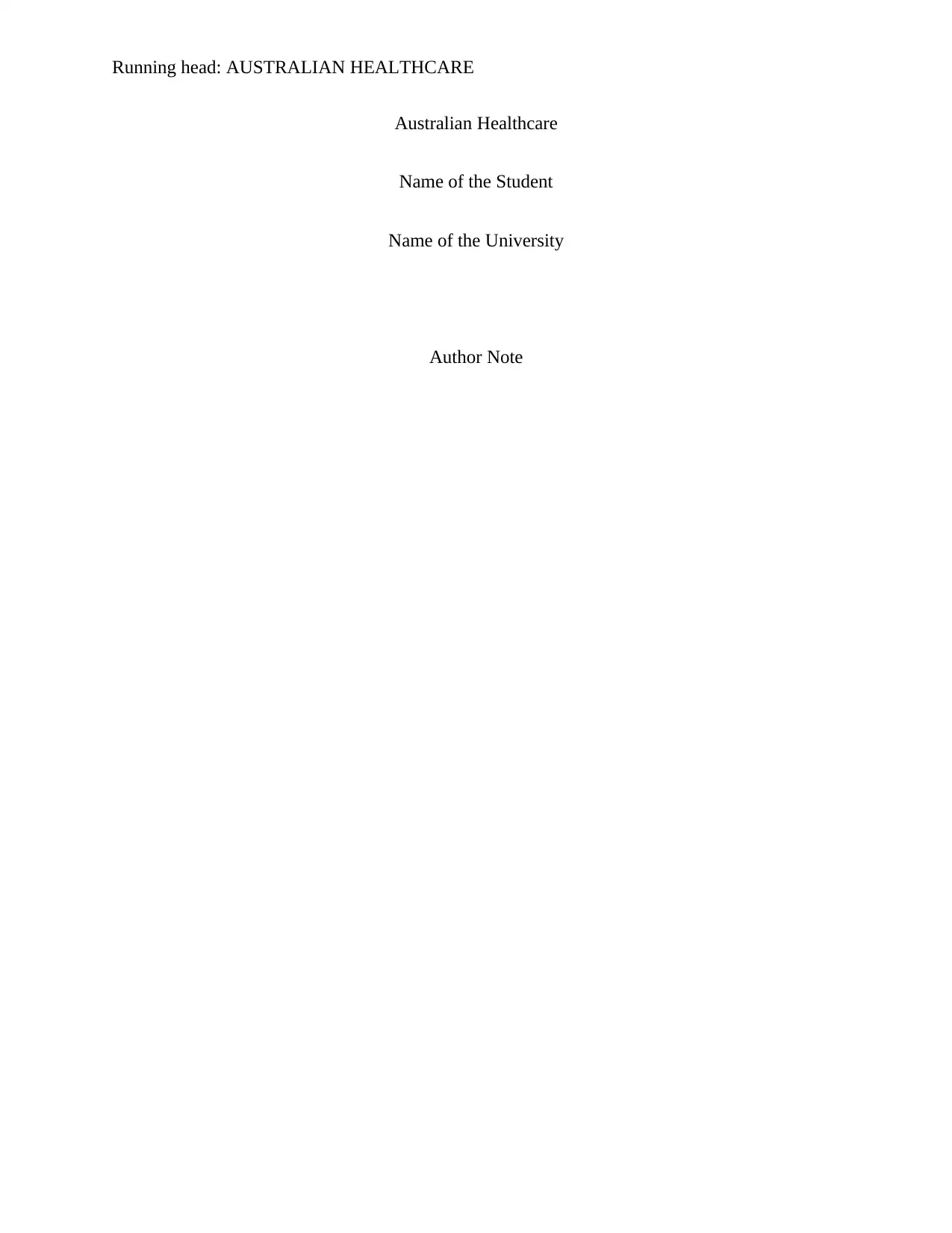
Running head: AUSTRALIAN HEALTHCARE
Australian Healthcare
Name of the Student
Name of the University
Author Note
Australian Healthcare
Name of the Student
Name of the University
Author Note
Paraphrase This Document
Need a fresh take? Get an instant paraphrase of this document with our AI Paraphraser
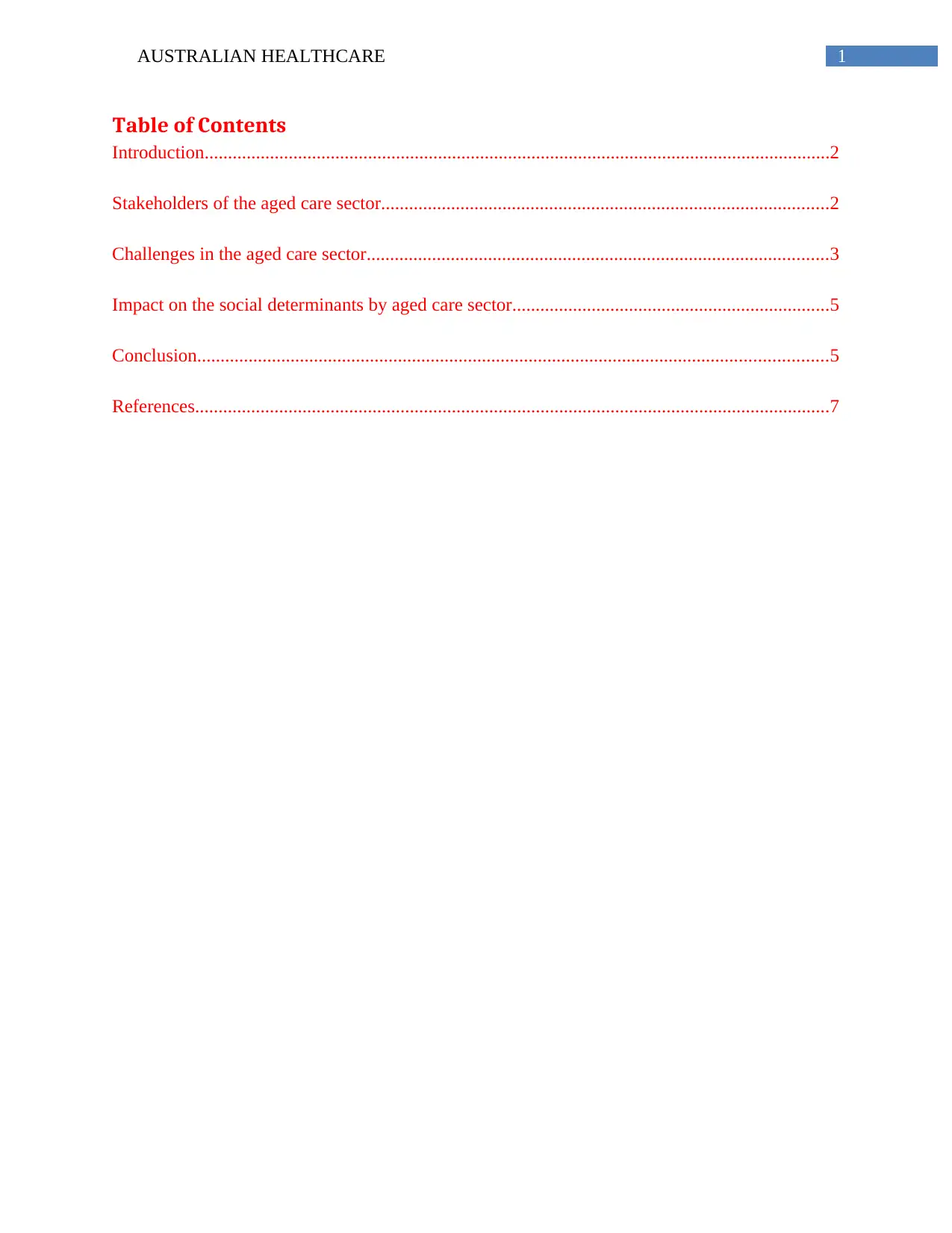
1AUSTRALIAN HEALTHCARE
Table of Contents
Introduction......................................................................................................................................2
Stakeholders of the aged care sector................................................................................................2
Challenges in the aged care sector...................................................................................................3
Impact on the social determinants by aged care sector....................................................................5
Conclusion.......................................................................................................................................5
References........................................................................................................................................7
Table of Contents
Introduction......................................................................................................................................2
Stakeholders of the aged care sector................................................................................................2
Challenges in the aged care sector...................................................................................................3
Impact on the social determinants by aged care sector....................................................................5
Conclusion.......................................................................................................................................5
References........................................................................................................................................7
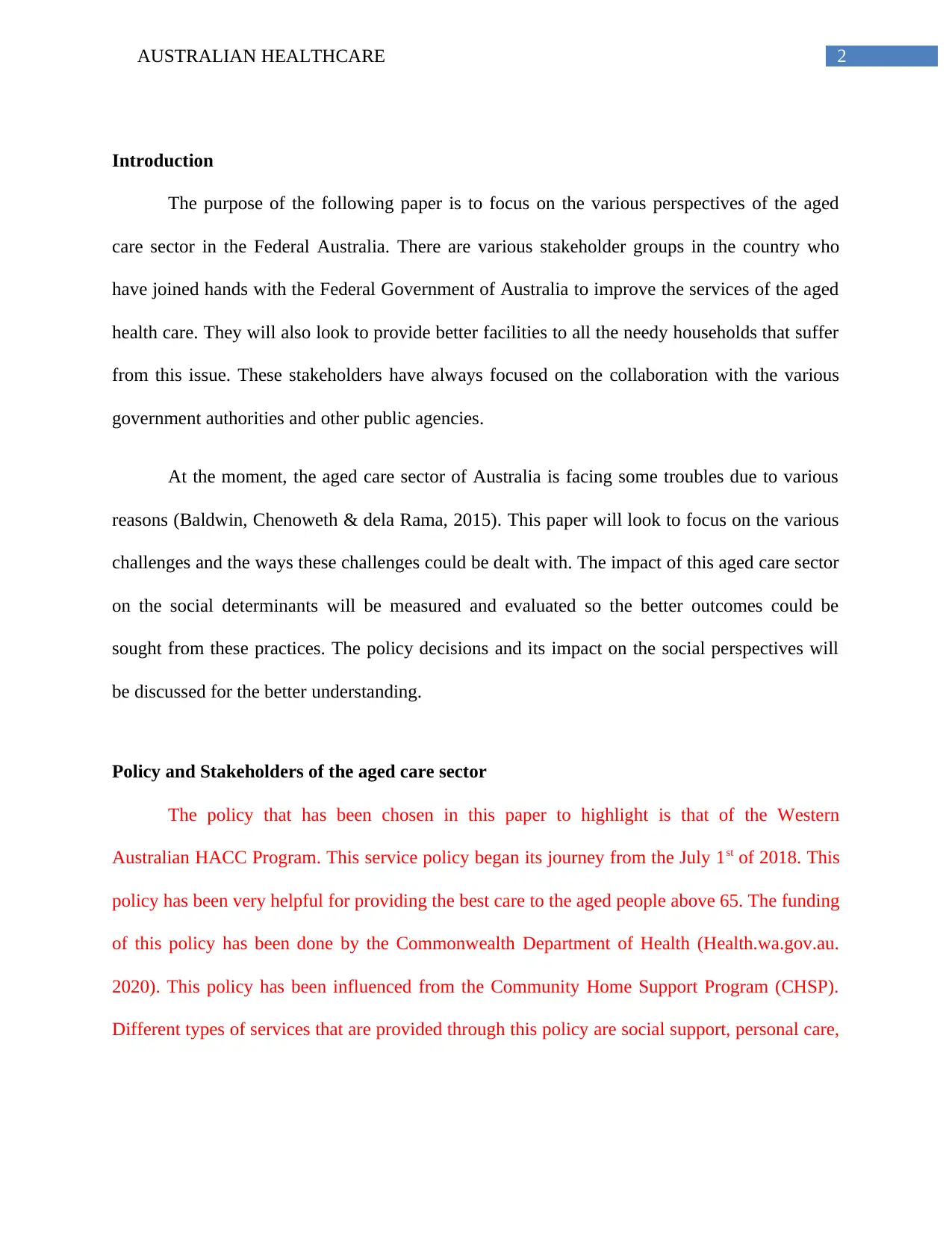
2AUSTRALIAN HEALTHCARE
Introduction
The purpose of the following paper is to focus on the various perspectives of the aged
care sector in the Federal Australia. There are various stakeholder groups in the country who
have joined hands with the Federal Government of Australia to improve the services of the aged
health care. They will also look to provide better facilities to all the needy households that suffer
from this issue. These stakeholders have always focused on the collaboration with the various
government authorities and other public agencies.
At the moment, the aged care sector of Australia is facing some troubles due to various
reasons (Baldwin, Chenoweth & dela Rama, 2015). This paper will look to focus on the various
challenges and the ways these challenges could be dealt with. The impact of this aged care sector
on the social determinants will be measured and evaluated so the better outcomes could be
sought from these practices. The policy decisions and its impact on the social perspectives will
be discussed for the better understanding.
Policy and Stakeholders of the aged care sector
The policy that has been chosen in this paper to highlight is that of the Western
Australian HACC Program. This service policy began its journey from the July 1st of 2018. This
policy has been very helpful for providing the best care to the aged people above 65. The funding
of this policy has been done by the Commonwealth Department of Health (Health.wa.gov.au.
2020). This policy has been influenced from the Community Home Support Program (CHSP).
Different types of services that are provided through this policy are social support, personal care,
Introduction
The purpose of the following paper is to focus on the various perspectives of the aged
care sector in the Federal Australia. There are various stakeholder groups in the country who
have joined hands with the Federal Government of Australia to improve the services of the aged
health care. They will also look to provide better facilities to all the needy households that suffer
from this issue. These stakeholders have always focused on the collaboration with the various
government authorities and other public agencies.
At the moment, the aged care sector of Australia is facing some troubles due to various
reasons (Baldwin, Chenoweth & dela Rama, 2015). This paper will look to focus on the various
challenges and the ways these challenges could be dealt with. The impact of this aged care sector
on the social determinants will be measured and evaluated so the better outcomes could be
sought from these practices. The policy decisions and its impact on the social perspectives will
be discussed for the better understanding.
Policy and Stakeholders of the aged care sector
The policy that has been chosen in this paper to highlight is that of the Western
Australian HACC Program. This service policy began its journey from the July 1st of 2018. This
policy has been very helpful for providing the best care to the aged people above 65. The funding
of this policy has been done by the Commonwealth Department of Health (Health.wa.gov.au.
2020). This policy has been influenced from the Community Home Support Program (CHSP).
Different types of services that are provided through this policy are social support, personal care,
⊘ This is a preview!⊘
Do you want full access?
Subscribe today to unlock all pages.

Trusted by 1+ million students worldwide
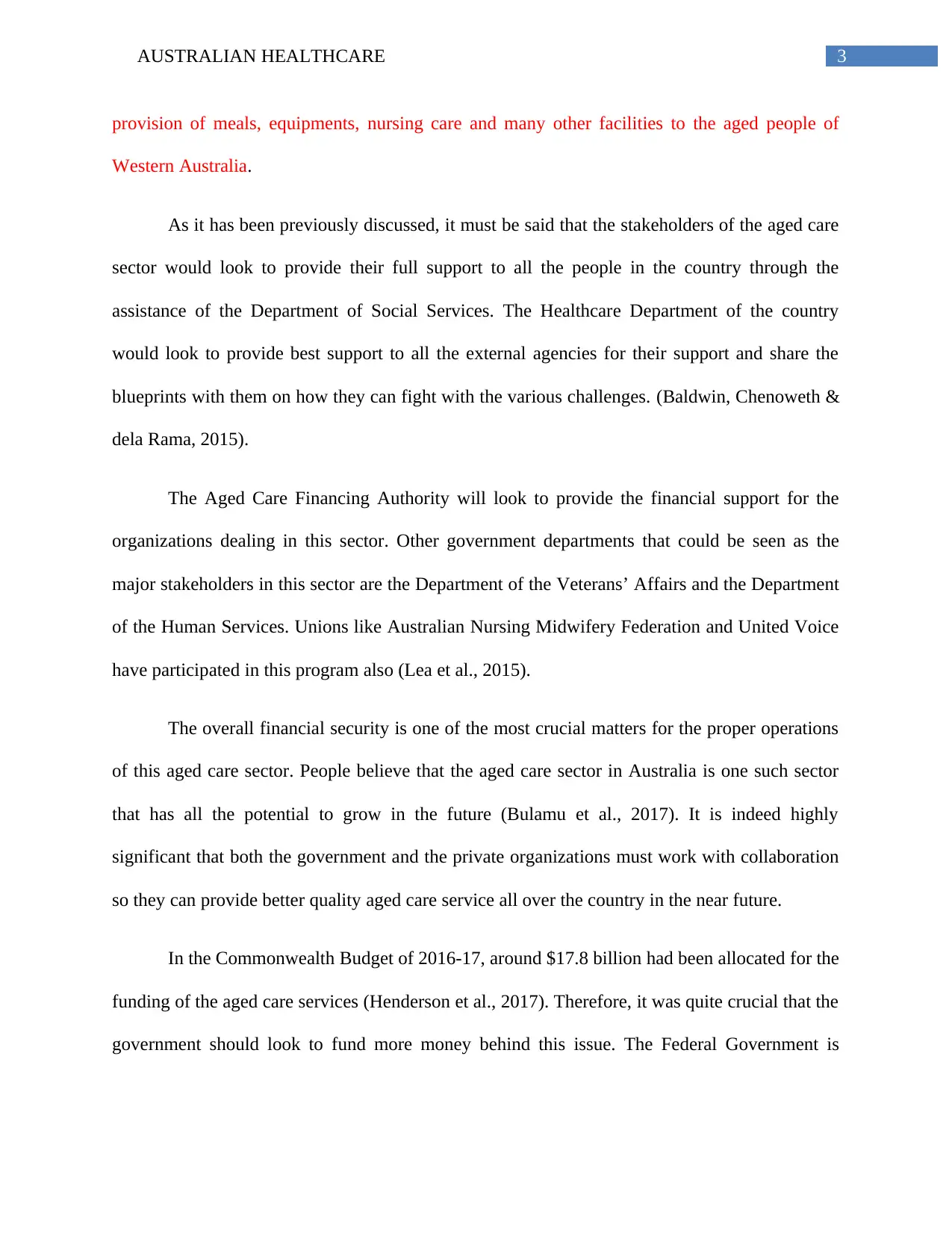
3AUSTRALIAN HEALTHCARE
provision of meals, equipments, nursing care and many other facilities to the aged people of
Western Australia.
As it has been previously discussed, it must be said that the stakeholders of the aged care
sector would look to provide their full support to all the people in the country through the
assistance of the Department of Social Services. The Healthcare Department of the country
would look to provide best support to all the external agencies for their support and share the
blueprints with them on how they can fight with the various challenges. (Baldwin, Chenoweth &
dela Rama, 2015).
The Aged Care Financing Authority will look to provide the financial support for the
organizations dealing in this sector. Other government departments that could be seen as the
major stakeholders in this sector are the Department of the Veterans’ Affairs and the Department
of the Human Services. Unions like Australian Nursing Midwifery Federation and United Voice
have participated in this program also (Lea et al., 2015).
The overall financial security is one of the most crucial matters for the proper operations
of this aged care sector. People believe that the aged care sector in Australia is one such sector
that has all the potential to grow in the future (Bulamu et al., 2017). It is indeed highly
significant that both the government and the private organizations must work with collaboration
so they can provide better quality aged care service all over the country in the near future.
In the Commonwealth Budget of 2016-17, around $17.8 billion had been allocated for the
funding of the aged care services (Henderson et al., 2017). Therefore, it was quite crucial that the
government should look to fund more money behind this issue. The Federal Government is
provision of meals, equipments, nursing care and many other facilities to the aged people of
Western Australia.
As it has been previously discussed, it must be said that the stakeholders of the aged care
sector would look to provide their full support to all the people in the country through the
assistance of the Department of Social Services. The Healthcare Department of the country
would look to provide best support to all the external agencies for their support and share the
blueprints with them on how they can fight with the various challenges. (Baldwin, Chenoweth &
dela Rama, 2015).
The Aged Care Financing Authority will look to provide the financial support for the
organizations dealing in this sector. Other government departments that could be seen as the
major stakeholders in this sector are the Department of the Veterans’ Affairs and the Department
of the Human Services. Unions like Australian Nursing Midwifery Federation and United Voice
have participated in this program also (Lea et al., 2015).
The overall financial security is one of the most crucial matters for the proper operations
of this aged care sector. People believe that the aged care sector in Australia is one such sector
that has all the potential to grow in the future (Bulamu et al., 2017). It is indeed highly
significant that both the government and the private organizations must work with collaboration
so they can provide better quality aged care service all over the country in the near future.
In the Commonwealth Budget of 2016-17, around $17.8 billion had been allocated for the
funding of the aged care services (Henderson et al., 2017). Therefore, it was quite crucial that the
government should look to fund more money behind this issue. The Federal Government is
Paraphrase This Document
Need a fresh take? Get an instant paraphrase of this document with our AI Paraphraser
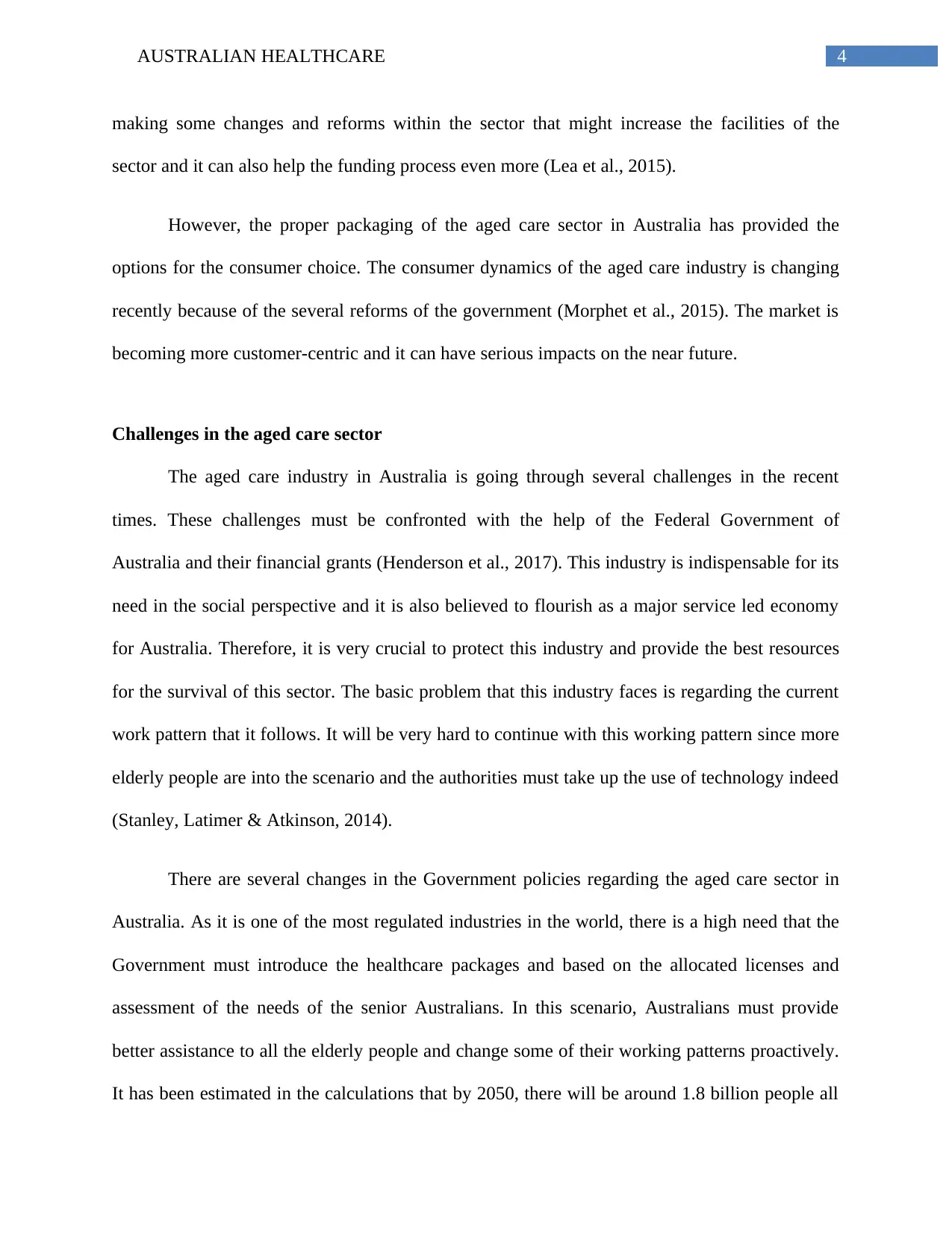
4AUSTRALIAN HEALTHCARE
making some changes and reforms within the sector that might increase the facilities of the
sector and it can also help the funding process even more (Lea et al., 2015).
However, the proper packaging of the aged care sector in Australia has provided the
options for the consumer choice. The consumer dynamics of the aged care industry is changing
recently because of the several reforms of the government (Morphet et al., 2015). The market is
becoming more customer-centric and it can have serious impacts on the near future.
Challenges in the aged care sector
The aged care industry in Australia is going through several challenges in the recent
times. These challenges must be confronted with the help of the Federal Government of
Australia and their financial grants (Henderson et al., 2017). This industry is indispensable for its
need in the social perspective and it is also believed to flourish as a major service led economy
for Australia. Therefore, it is very crucial to protect this industry and provide the best resources
for the survival of this sector. The basic problem that this industry faces is regarding the current
work pattern that it follows. It will be very hard to continue with this working pattern since more
elderly people are into the scenario and the authorities must take up the use of technology indeed
(Stanley, Latimer & Atkinson, 2014).
There are several changes in the Government policies regarding the aged care sector in
Australia. As it is one of the most regulated industries in the world, there is a high need that the
Government must introduce the healthcare packages and based on the allocated licenses and
assessment of the needs of the senior Australians. In this scenario, Australians must provide
better assistance to all the elderly people and change some of their working patterns proactively.
It has been estimated in the calculations that by 2050, there will be around 1.8 billion people all
making some changes and reforms within the sector that might increase the facilities of the
sector and it can also help the funding process even more (Lea et al., 2015).
However, the proper packaging of the aged care sector in Australia has provided the
options for the consumer choice. The consumer dynamics of the aged care industry is changing
recently because of the several reforms of the government (Morphet et al., 2015). The market is
becoming more customer-centric and it can have serious impacts on the near future.
Challenges in the aged care sector
The aged care industry in Australia is going through several challenges in the recent
times. These challenges must be confronted with the help of the Federal Government of
Australia and their financial grants (Henderson et al., 2017). This industry is indispensable for its
need in the social perspective and it is also believed to flourish as a major service led economy
for Australia. Therefore, it is very crucial to protect this industry and provide the best resources
for the survival of this sector. The basic problem that this industry faces is regarding the current
work pattern that it follows. It will be very hard to continue with this working pattern since more
elderly people are into the scenario and the authorities must take up the use of technology indeed
(Stanley, Latimer & Atkinson, 2014).
There are several changes in the Government policies regarding the aged care sector in
Australia. As it is one of the most regulated industries in the world, there is a high need that the
Government must introduce the healthcare packages and based on the allocated licenses and
assessment of the needs of the senior Australians. In this scenario, Australians must provide
better assistance to all the elderly people and change some of their working patterns proactively.
It has been estimated in the calculations that by 2050, there will be around 1.8 billion people all
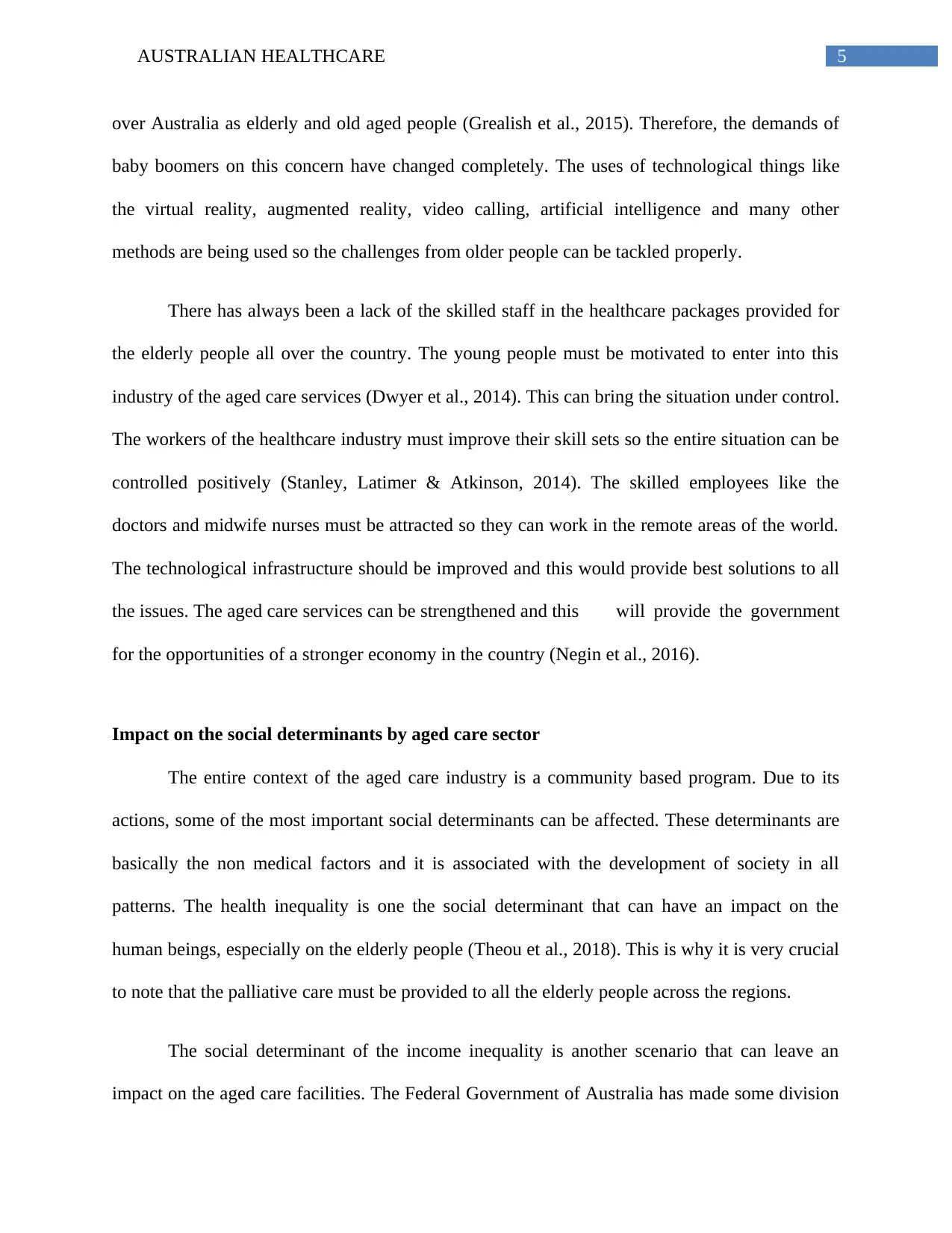
5AUSTRALIAN HEALTHCARE
over Australia as elderly and old aged people (Grealish et al., 2015). Therefore, the demands of
baby boomers on this concern have changed completely. The uses of technological things like
the virtual reality, augmented reality, video calling, artificial intelligence and many other
methods are being used so the challenges from older people can be tackled properly.
There has always been a lack of the skilled staff in the healthcare packages provided for
the elderly people all over the country. The young people must be motivated to enter into this
industry of the aged care services (Dwyer et al., 2014). This can bring the situation under control.
The workers of the healthcare industry must improve their skill sets so the entire situation can be
controlled positively (Stanley, Latimer & Atkinson, 2014). The skilled employees like the
doctors and midwife nurses must be attracted so they can work in the remote areas of the world.
The technological infrastructure should be improved and this would provide best solutions to all
the issues. The aged care services can be strengthened and this will provide the government
for the opportunities of a stronger economy in the country (Negin et al., 2016).
Impact on the social determinants by aged care sector
The entire context of the aged care industry is a community based program. Due to its
actions, some of the most important social determinants can be affected. These determinants are
basically the non medical factors and it is associated with the development of society in all
patterns. The health inequality is one the social determinant that can have an impact on the
human beings, especially on the elderly people (Theou et al., 2018). This is why it is very crucial
to note that the palliative care must be provided to all the elderly people across the regions.
The social determinant of the income inequality is another scenario that can leave an
impact on the aged care facilities. The Federal Government of Australia has made some division
over Australia as elderly and old aged people (Grealish et al., 2015). Therefore, the demands of
baby boomers on this concern have changed completely. The uses of technological things like
the virtual reality, augmented reality, video calling, artificial intelligence and many other
methods are being used so the challenges from older people can be tackled properly.
There has always been a lack of the skilled staff in the healthcare packages provided for
the elderly people all over the country. The young people must be motivated to enter into this
industry of the aged care services (Dwyer et al., 2014). This can bring the situation under control.
The workers of the healthcare industry must improve their skill sets so the entire situation can be
controlled positively (Stanley, Latimer & Atkinson, 2014). The skilled employees like the
doctors and midwife nurses must be attracted so they can work in the remote areas of the world.
The technological infrastructure should be improved and this would provide best solutions to all
the issues. The aged care services can be strengthened and this will provide the government
for the opportunities of a stronger economy in the country (Negin et al., 2016).
Impact on the social determinants by aged care sector
The entire context of the aged care industry is a community based program. Due to its
actions, some of the most important social determinants can be affected. These determinants are
basically the non medical factors and it is associated with the development of society in all
patterns. The health inequality is one the social determinant that can have an impact on the
human beings, especially on the elderly people (Theou et al., 2018). This is why it is very crucial
to note that the palliative care must be provided to all the elderly people across the regions.
The social determinant of the income inequality is another scenario that can leave an
impact on the aged care facilities. The Federal Government of Australia has made some division
⊘ This is a preview!⊘
Do you want full access?
Subscribe today to unlock all pages.

Trusted by 1+ million students worldwide
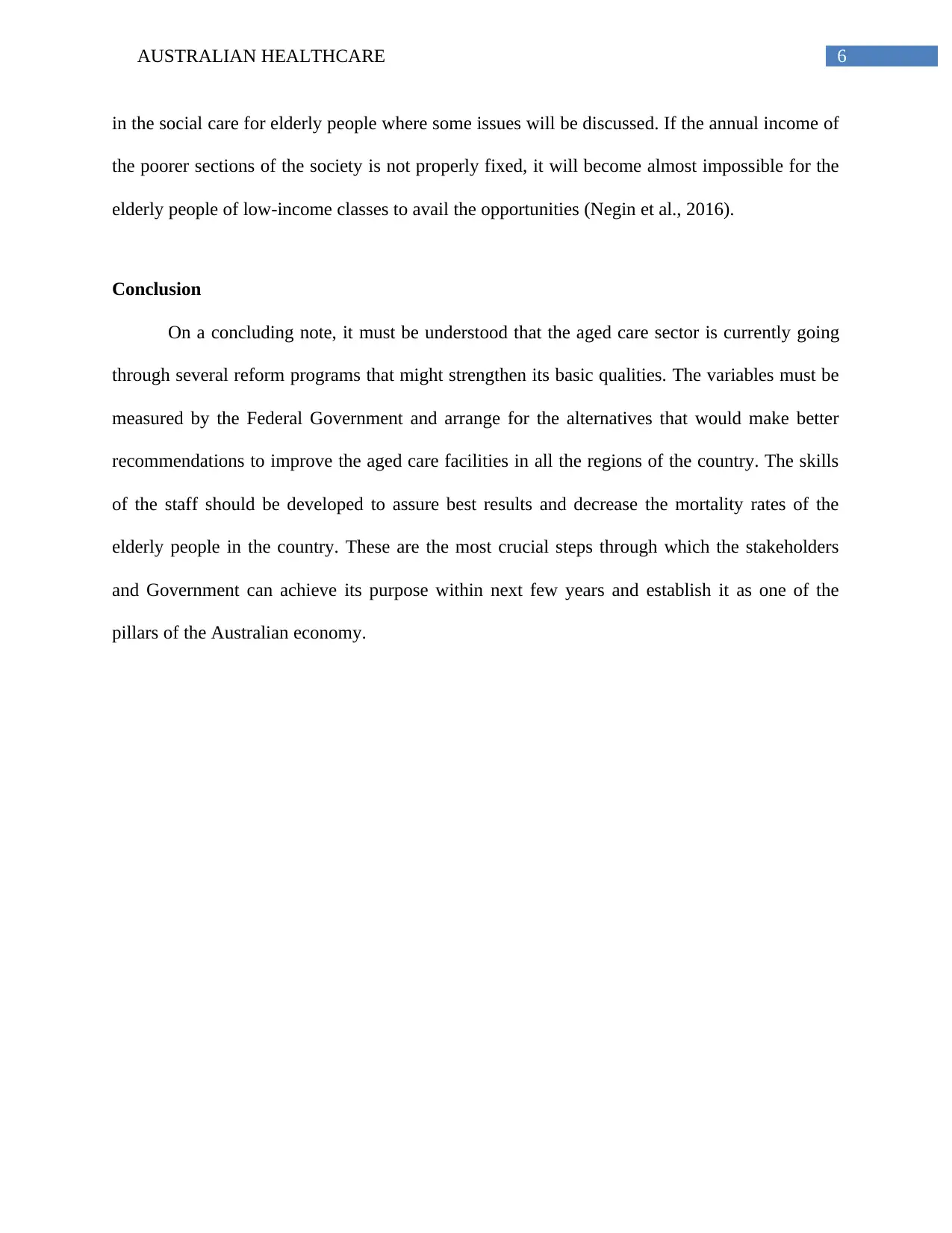
6AUSTRALIAN HEALTHCARE
in the social care for elderly people where some issues will be discussed. If the annual income of
the poorer sections of the society is not properly fixed, it will become almost impossible for the
elderly people of low-income classes to avail the opportunities (Negin et al., 2016).
Conclusion
On a concluding note, it must be understood that the aged care sector is currently going
through several reform programs that might strengthen its basic qualities. The variables must be
measured by the Federal Government and arrange for the alternatives that would make better
recommendations to improve the aged care facilities in all the regions of the country. The skills
of the staff should be developed to assure best results and decrease the mortality rates of the
elderly people in the country. These are the most crucial steps through which the stakeholders
and Government can achieve its purpose within next few years and establish it as one of the
pillars of the Australian economy.
in the social care for elderly people where some issues will be discussed. If the annual income of
the poorer sections of the society is not properly fixed, it will become almost impossible for the
elderly people of low-income classes to avail the opportunities (Negin et al., 2016).
Conclusion
On a concluding note, it must be understood that the aged care sector is currently going
through several reform programs that might strengthen its basic qualities. The variables must be
measured by the Federal Government and arrange for the alternatives that would make better
recommendations to improve the aged care facilities in all the regions of the country. The skills
of the staff should be developed to assure best results and decrease the mortality rates of the
elderly people in the country. These are the most crucial steps through which the stakeholders
and Government can achieve its purpose within next few years and establish it as one of the
pillars of the Australian economy.
Paraphrase This Document
Need a fresh take? Get an instant paraphrase of this document with our AI Paraphraser
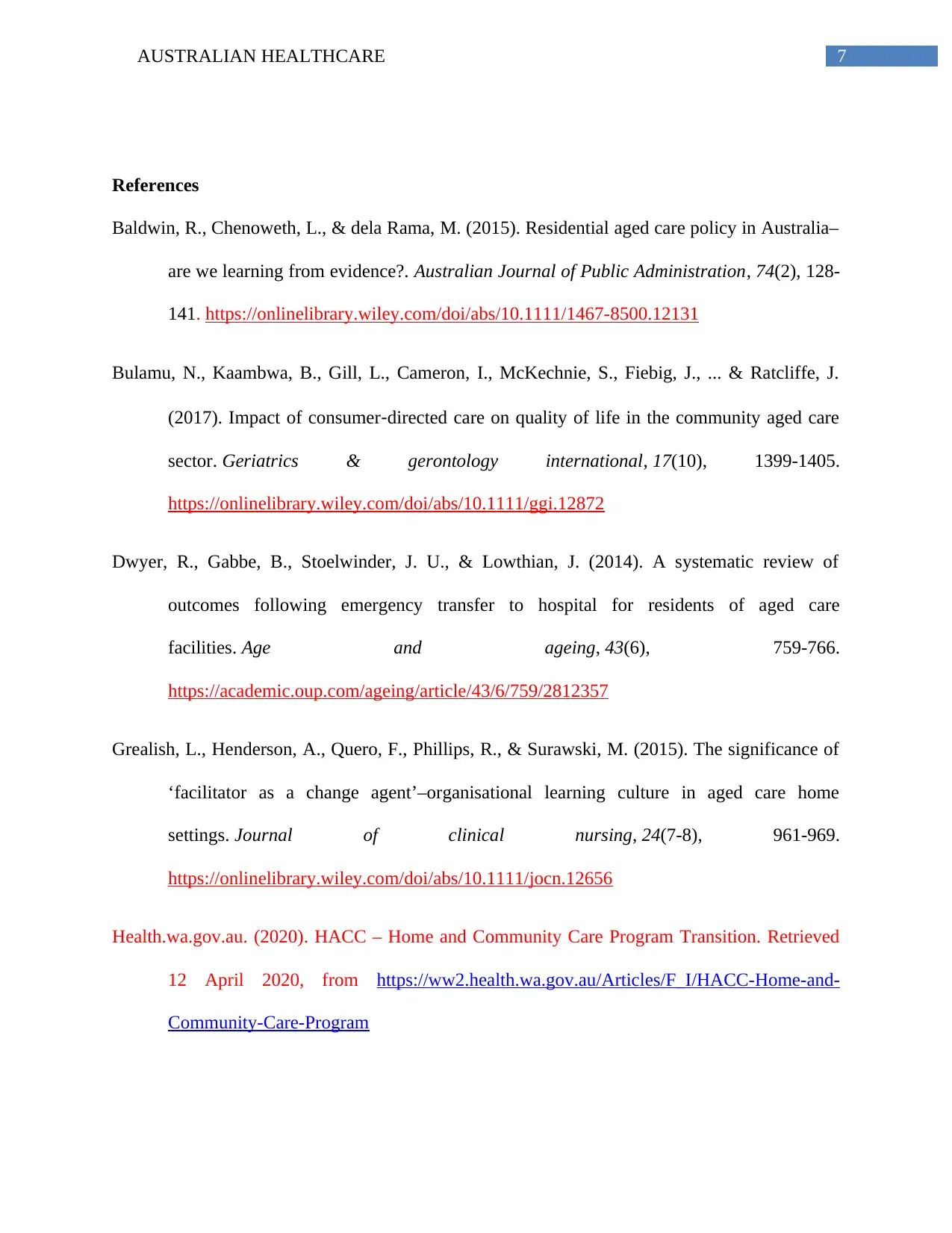
7AUSTRALIAN HEALTHCARE
References
Baldwin, R., Chenoweth, L., & dela Rama, M. (2015). Residential aged care policy in Australia–
are we learning from evidence?. Australian Journal of Public Administration, 74(2), 128-
141. https://onlinelibrary.wiley.com/doi/abs/10.1111/1467-8500.12131
Bulamu, N., Kaambwa, B., Gill, L., Cameron, I., McKechnie, S., Fiebig, J., ... & Ratcliffe, J.
(2017). Impact of consumer‐directed care on quality of life in the community aged care
sector. Geriatrics & gerontology international, 17(10), 1399-1405.
https://onlinelibrary.wiley.com/doi/abs/10.1111/ggi.12872
Dwyer, R., Gabbe, B., Stoelwinder, J. U., & Lowthian, J. (2014). A systematic review of
outcomes following emergency transfer to hospital for residents of aged care
facilities. Age and ageing, 43(6), 759-766.
https://academic.oup.com/ageing/article/43/6/759/2812357
Grealish, L., Henderson, A., Quero, F., Phillips, R., & Surawski, M. (2015). The significance of
‘facilitator as a change agent’–organisational learning culture in aged care home
settings. Journal of clinical nursing, 24(7-8), 961-969.
https://onlinelibrary.wiley.com/doi/abs/10.1111/jocn.12656
Health.wa.gov.au. (2020). HACC – Home and Community Care Program Transition. Retrieved
12 April 2020, from https://ww2.health.wa.gov.au/Articles/F_I/HACC-Home-and-
Community-Care-Program
References
Baldwin, R., Chenoweth, L., & dela Rama, M. (2015). Residential aged care policy in Australia–
are we learning from evidence?. Australian Journal of Public Administration, 74(2), 128-
141. https://onlinelibrary.wiley.com/doi/abs/10.1111/1467-8500.12131
Bulamu, N., Kaambwa, B., Gill, L., Cameron, I., McKechnie, S., Fiebig, J., ... & Ratcliffe, J.
(2017). Impact of consumer‐directed care on quality of life in the community aged care
sector. Geriatrics & gerontology international, 17(10), 1399-1405.
https://onlinelibrary.wiley.com/doi/abs/10.1111/ggi.12872
Dwyer, R., Gabbe, B., Stoelwinder, J. U., & Lowthian, J. (2014). A systematic review of
outcomes following emergency transfer to hospital for residents of aged care
facilities. Age and ageing, 43(6), 759-766.
https://academic.oup.com/ageing/article/43/6/759/2812357
Grealish, L., Henderson, A., Quero, F., Phillips, R., & Surawski, M. (2015). The significance of
‘facilitator as a change agent’–organisational learning culture in aged care home
settings. Journal of clinical nursing, 24(7-8), 961-969.
https://onlinelibrary.wiley.com/doi/abs/10.1111/jocn.12656
Health.wa.gov.au. (2020). HACC – Home and Community Care Program Transition. Retrieved
12 April 2020, from https://ww2.health.wa.gov.au/Articles/F_I/HACC-Home-and-
Community-Care-Program
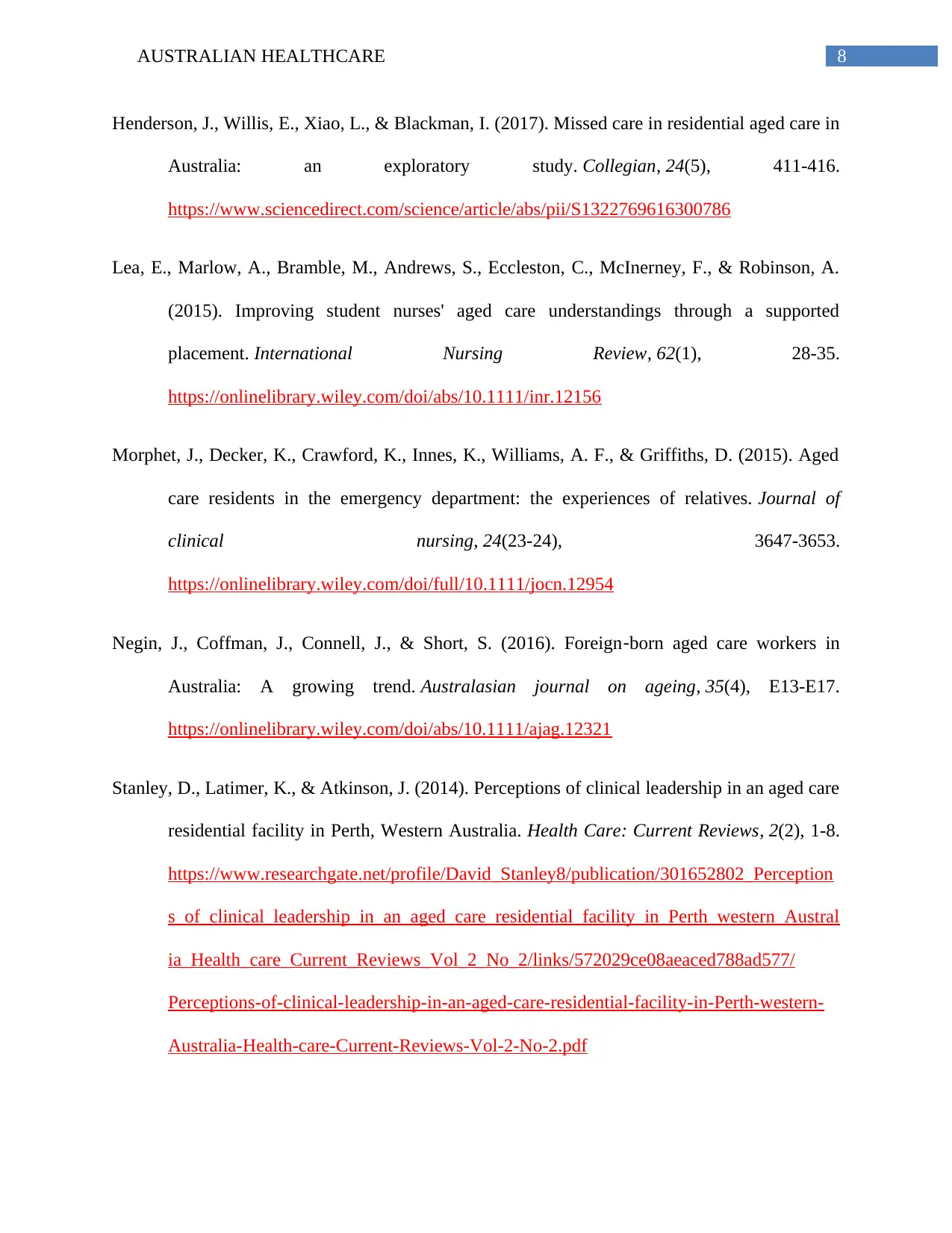
8AUSTRALIAN HEALTHCARE
Henderson, J., Willis, E., Xiao, L., & Blackman, I. (2017). Missed care in residential aged care in
Australia: an exploratory study. Collegian, 24(5), 411-416.
https://www.sciencedirect.com/science/article/abs/pii/S1322769616300786
Lea, E., Marlow, A., Bramble, M., Andrews, S., Eccleston, C., McInerney, F., & Robinson, A.
(2015). Improving student nurses' aged care understandings through a supported
placement. International Nursing Review, 62(1), 28-35.
https://onlinelibrary.wiley.com/doi/abs/10.1111/inr.12156
Morphet, J., Decker, K., Crawford, K., Innes, K., Williams, A. F., & Griffiths, D. (2015). Aged
care residents in the emergency department: the experiences of relatives. Journal of
clinical nursing, 24(23-24), 3647-3653.
https://onlinelibrary.wiley.com/doi/full/10.1111/jocn.12954
Negin, J., Coffman, J., Connell, J., & Short, S. (2016). Foreign‐born aged care workers in
Australia: A growing trend. Australasian journal on ageing, 35(4), E13-E17.
https://onlinelibrary.wiley.com/doi/abs/10.1111/ajag.12321
Stanley, D., Latimer, K., & Atkinson, J. (2014). Perceptions of clinical leadership in an aged care
residential facility in Perth, Western Australia. Health Care: Current Reviews, 2(2), 1-8.
https://www.researchgate.net/profile/David_Stanley8/publication/301652802_Perception
s_of_clinical_leadership_in_an_aged_care_residential_facility_in_Perth_western_Austral
ia_Health_care_Current_Reviews_Vol_2_No_2/links/572029ce08aeaced788ad577/
Perceptions-of-clinical-leadership-in-an-aged-care-residential-facility-in-Perth-western-
Australia-Health-care-Current-Reviews-Vol-2-No-2.pdf
Henderson, J., Willis, E., Xiao, L., & Blackman, I. (2017). Missed care in residential aged care in
Australia: an exploratory study. Collegian, 24(5), 411-416.
https://www.sciencedirect.com/science/article/abs/pii/S1322769616300786
Lea, E., Marlow, A., Bramble, M., Andrews, S., Eccleston, C., McInerney, F., & Robinson, A.
(2015). Improving student nurses' aged care understandings through a supported
placement. International Nursing Review, 62(1), 28-35.
https://onlinelibrary.wiley.com/doi/abs/10.1111/inr.12156
Morphet, J., Decker, K., Crawford, K., Innes, K., Williams, A. F., & Griffiths, D. (2015). Aged
care residents in the emergency department: the experiences of relatives. Journal of
clinical nursing, 24(23-24), 3647-3653.
https://onlinelibrary.wiley.com/doi/full/10.1111/jocn.12954
Negin, J., Coffman, J., Connell, J., & Short, S. (2016). Foreign‐born aged care workers in
Australia: A growing trend. Australasian journal on ageing, 35(4), E13-E17.
https://onlinelibrary.wiley.com/doi/abs/10.1111/ajag.12321
Stanley, D., Latimer, K., & Atkinson, J. (2014). Perceptions of clinical leadership in an aged care
residential facility in Perth, Western Australia. Health Care: Current Reviews, 2(2), 1-8.
https://www.researchgate.net/profile/David_Stanley8/publication/301652802_Perception
s_of_clinical_leadership_in_an_aged_care_residential_facility_in_Perth_western_Austral
ia_Health_care_Current_Reviews_Vol_2_No_2/links/572029ce08aeaced788ad577/
Perceptions-of-clinical-leadership-in-an-aged-care-residential-facility-in-Perth-western-
Australia-Health-care-Current-Reviews-Vol-2-No-2.pdf
⊘ This is a preview!⊘
Do you want full access?
Subscribe today to unlock all pages.

Trusted by 1+ million students worldwide
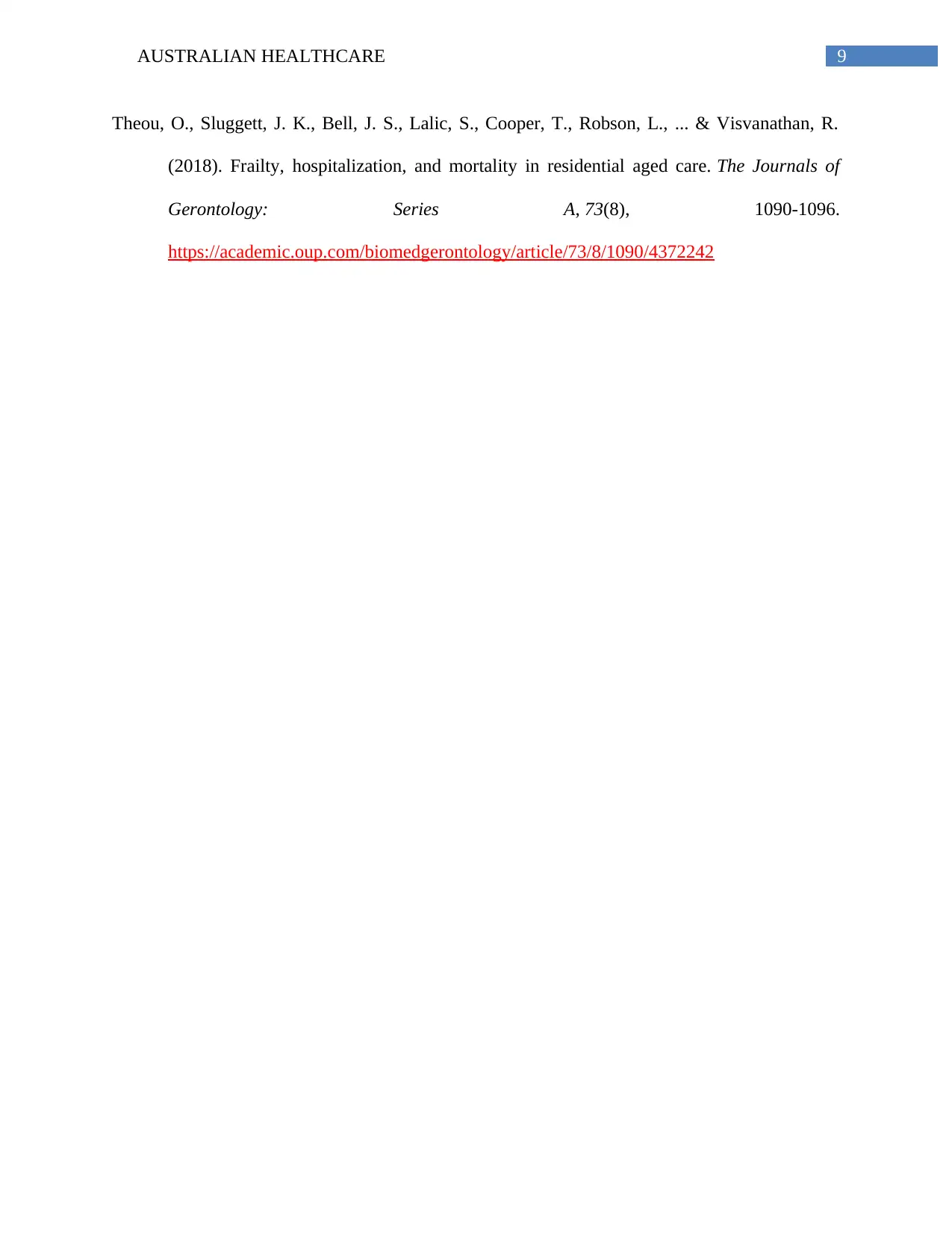
9AUSTRALIAN HEALTHCARE
Theou, O., Sluggett, J. K., Bell, J. S., Lalic, S., Cooper, T., Robson, L., ... & Visvanathan, R.
(2018). Frailty, hospitalization, and mortality in residential aged care. The Journals of
Gerontology: Series A, 73(8), 1090-1096.
https://academic.oup.com/biomedgerontology/article/73/8/1090/4372242
Theou, O., Sluggett, J. K., Bell, J. S., Lalic, S., Cooper, T., Robson, L., ... & Visvanathan, R.
(2018). Frailty, hospitalization, and mortality in residential aged care. The Journals of
Gerontology: Series A, 73(8), 1090-1096.
https://academic.oup.com/biomedgerontology/article/73/8/1090/4372242
1 out of 10
Related Documents
Your All-in-One AI-Powered Toolkit for Academic Success.
+13062052269
info@desklib.com
Available 24*7 on WhatsApp / Email
![[object Object]](/_next/static/media/star-bottom.7253800d.svg)
Unlock your academic potential
Copyright © 2020–2025 A2Z Services. All Rights Reserved. Developed and managed by ZUCOL.





